Replaces
2012 Chevrolet Avalanche Front 12 Piece Steering & Suspension Kit TRQ PSA43376
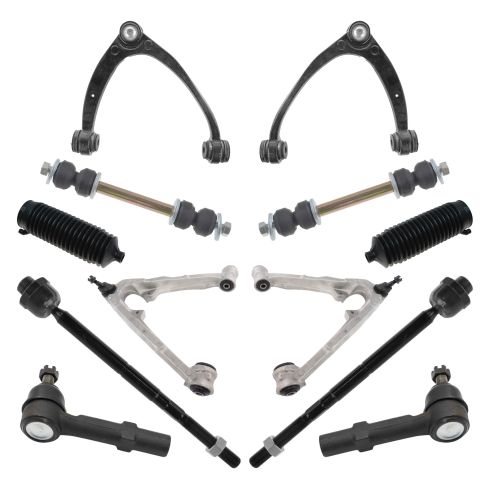

PSA43376
In Stock
This part doesn’t fit a . Select from parts that fit.
Specify your vehicle's year, make and model to guarantee fit.
Orders must be placed by 2pm ET
You may also like
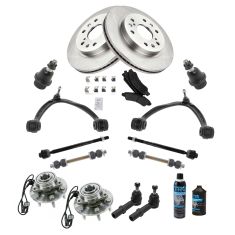
Semi-Metallic 17 Piece Steering, Suspension, & Brake Kit 12oz
$489.95
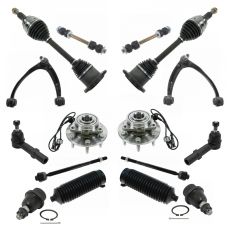
Steering, Suspension, & Drivetrain Kit
$494.95
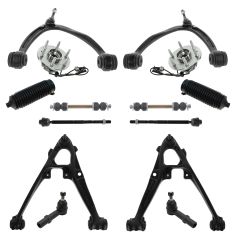
14 Piece Steering, Suspension, & Drivetrain Kit
$534.95
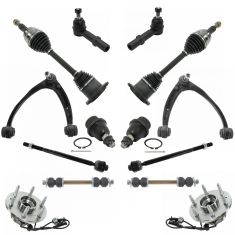
14 Piece Steering, Suspension, & Drivetrain Kit
$579.95
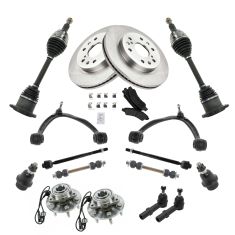
Semi-Metallic 17 Piece Steering, Suspension, & Brake Kit
$619.95
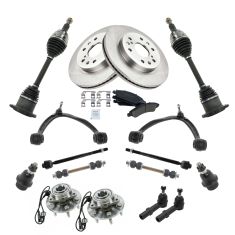
Ceramic 17 Piece Steering, Suspension, & Brake Kit
$629.95
Part Details
- Quantity: 12 Piece
-
Kit Includes:
(2) Front Sway Bar Links
(2) Front Lower Control Arms with Ball Joints
(2) Front Outer Tie Rods
(2) Front Upper Control Arms with Ball Joints
(2) Front Steering Rack & Pinion Bellows
(2) Front Inner Tie Rods
Specification
- Front
TRQ suspension kits are manufactured using premium raw materials and coatings for extended service life. Each TRQ suspension component is designed to be a direct, maintenance-free replacement to the stock unit. To extend the life of your steering and suspension components, TRQ recommends replacing components in pairs, sets, or kits. All products are fit and road-tested in our Massachusetts R&D facility to ensure we deliver on our promise of Trusted Reliable Quality.
Product Features
Install Tip: When replacing steering components, have a professional alignment performed afterwards. This ensures proper tracking and even tire wear.
Our steering and suspension components are pre-greased and sealed for long life and do not require the extra maintenance typically required by greaseable versions.
Item Condition:
New
Attention California Customers:
![]() WARNING: This product can expose you to chemicals including Lead and Lead Compounds, which are known to the State of California to cause cancer, and birth defects or other reproductive harm. For more information, go to www.P65Warnings.ca.gov.
WARNING: This product can expose you to chemicals including Lead and Lead Compounds, which are known to the State of California to cause cancer, and birth defects or other reproductive harm. For more information, go to www.P65Warnings.ca.gov.
Lifetime Warranty
This item is backed by our limited lifetime warranty. In the event that this item should fail due to manufacturing defects during intended use, we will replace the part free of charge. This warranty covers the cost of the part only.









Created on:
Tools used
One of the first things you wanna do is safely raise and support your vehicle by the frame so your suspension can hang. Once you've done that, take a small pry bar, and we're gonna take off this center cap. If you were to spin it, you're gonna see a little notch in the cap. Carefully slide this off of here. That exposes our 22-millimeter lug nuts. Remove all six. Remove your wheel.
Now that we have the wheel off, we have a clear view of our tie rod area. One of the first things we're gonna do is break free this jam nut right here. I like to use a nice, long pair of pliers like this. You could also use a wrench. Right on here like that. Once it turns like this, that means it broke free from the outer tie rod end, and now you'll be able to continue. Now let's remove our 21-millimeter nut. Let's just put that nut on, just a couple threads. Now we're gonna take a hammer, and we're gonna hit right here on the knuckle. You wanna be very careful for your brake rotor.
The next thing we're gonna do is remove our outer tie rod end, and as you screw if off, just count those threads. One, two, and so on. All right. Go ahead and write that number down. Now it's time to install the outer tie rod end. Make sure you put it in the same amount of threads that you did to take it off. One, two, three, and so on. Get that nut off of there. Okay. So now with it sitting as it is, you just wanna kind of go to the front of the vehicle and make sure that both wheels are aiming straight ahead at this point. Now that everything looks like it's going in a nice and straight line, go ahead and bring that jam nut so it's hitting up against the outer tie rod end. It's good right there. Let's go ahead and grab some pliers.
The next thing we're gonna do is take a nice wrench, 1-inch will work perfectly, and we're gonna grab right onto this area on the outer tie rod end, and then we'll take our nice, long pliers and go ahead and snug up this jam nut. Okay. That feels good. Go ahead and wiggle that tie rod around a little bit. Make sure it's facing straight up and down. This looks good. Now let's go ahead and snug this up. We're gonna bottom it out. Now you're gonna torque this to 44-foot-pounds. That's torqued. The next thing we're gonna do is look to see if we can find the hole in the stud of the tie rod, and match it with the next corresponding slot on the tie rod stud nut. This doesn't line up, so what I need to do now is I need to continue tightening until it does. I can see right through. I'm gonna grab that locking cotter pin and install it. Slide that right on through. Then just peen it over. There's no way that this nut can come loose.
We'll grab those lug nuts, start them all on there. Let's bottom these out. Now we'll bring it down to the ground, and we'll make it so the wheel is just barely touching enough so the wheel can't spin. Now let's do the lug nuts, 140-foot-pounds. Go crisscross. Torqued.
Now it's gonna be time to get the center cover on. Before you go ahead and pound it on there, just take a look at the back. You're gonna see something that looks a lot like a valve stem. Line it up. It's gonna go pretty much just like this. Light bonk. And then, of course, clean up your wheel, make it look nice and pretty, and take it for a road test.
Tools used
Tools used
Tools used
Tools used
One of the first things you want to do is safely raise and support your vehicle by the frame, so your suspension can hang. Once you've done that, take a small pry bar, and we're going to take off this center cap. If you were to spin it, you're going to see a little notch in the cap. Just carefully slide this off of here. That exposes our 22-millimeter lug nuts. Remove all six. Remove your wheel.
Now, that we have the wheel off, we have a clear view of our tie rod area. One of the first things we're going to do is break free this jam nut right here. I like to use a nice long pair of pliers like this. You could also use a wrench right on here like that. Once it turns like this, that means it broke free from the outer tie rod end, and now you'll be able to continue. Now, let's remove our 21-millimeter nut. Let's just put that nut on just a couple threads. Now, we're going to take a hammer and we're going to hit right here on the knuckle. You want to be very careful for your brake rotor. The next thing we're going to do is remove our outer tie rod end, and as you screw it off, just count those threads, one, two, and so on. All right, go ahead and write that number down. The next thing I would do is go ahead and blast this area with some penetrant again. Just for good measure, use some locking pliers. Hold on to the inner tie rod end, and then we're going to use a 24-millimeter socket and remove this. Now, if you were to look at this rubber boot right here, which is called your bellows boot, at this end, closest to the inner tie rod end shaft, you're going to have a little clip. Go ahead and grab that with some long-nose pliers.
Go right along the inner tie rod end. Grab. Squeeze. Draw it away. Remove it. Now, if you were to follow those bellows boot in, you're going to look to find a clamp that's holding the bellows boot to the power steering rack. Right along the frame and the boot, you're going to see a little nub right there. That's the area that the clamp is holding on by. What I like to do is I like to take a nice long pry bar, and I'll put the tip up against it, and come out just like this. And then I'm going to give it a couple loving blocks with a hammer and try to break it free.
Take my pry bar. Put it right up against that clip. Be careful not to damage your boot. One bonk. Set you free. That's what it looks like, friends. Now, we're just going to grab that inner tie rod boot. Go ahead and try to give it a twist to break it free, and then just give it a couple yanks. Go ahead and draw it right off of here. Now, is a great time to inspect the boot. Make sure it's not damaged in any way. This looks great.
The next thing we need to do is grab onto this portion of the inner tie rod end. You can either do that with a inner tie rod end tool, which overall will probably have a little clamp that goes over it. A little piece. You can put an extension with a 3/8 ratchet. You also have a different inner tie rod end tool that will have a nice long tube that will slide over with an adapter. Me personally, I love my nice long pliers. They're easy. Turn the wheel all the way to the left, so you can get to this. If you don't, you'll be inside here. Once you have it turned, go ahead and grab onto it. Turn it counterclockwise and break it free. Let's go ahead and remove that. There it is, friends.
The next thing I always like to do is just clean up the area. That looks pretty decent just like that. Make sure that there's nothing in the threads that's going to cause an issue. Now, it's going to be time to install our inner tie rod end. If you want to use a little bit of threadlocker, we'll call it your prerogative. I like to thread it in by hand. Okay. That's as tight as it's going to go. Now, I'm just going to go ahead and continue on by tightening it up. At this point with it being bottomed out, you really don't want to go too much further because if you apply too much pressure, you'll twist the inner portion of the rack, which will cause an issue. Okay. Just give it a little bit. That's it right there. Now, what you're going to notice is your inner tie rod end is going to come with this nice little package of grease. Go ahead and tear open a little corner of it, and then we're going to take the grease and go right along the ball and socket area, which is this area right here. Just put it in. Wiggle it around. This is going to help keep moisture out of there, and it's going to help keep it well lubricated for a long period of time. I like to put a little bit of grease right along her, right where this line is, that's where the bellows boot clamp is going to be. So, let's get this jam nut off of here.
The next thing we're going to do is go ahead and straighten out the wheel, so it's back to its original area. We're going to take our bellows boot, just like this, and I like to use a nice wire tie, and I'm just going to go right along it. Get it started on there. I'll leave it pretty loose at this point, but I'm going to trim off some of the slack just so I can get inside this area. Now, we're just going to take that inner tie rod end boot. Slide it right on over. Okay. It got to the grease. I'm just going to work it around a little bit. By having grease right here, that's going to make it so when it comes time for the alignment and they're turning this, it's going to turn easy-peasy, and your alignment professional is going to be very happy. Go ahead and slide it over the power steering rack down here. Once you're sure it's completely seated all the way around, go ahead and snug up that wire tie with some pliers, and then trim off the excess.
Now, it's going to be time to get this clamp back on there. Go ahead and carefully squeeze on it. Just watch your fingers. It is spring metal or spring steel. Slide it right on over. Make sure it's sitting flush all the way around, not hanging off anywhere, and the boot is definitely secured to the inner tie rod end. This is going to prevent moisture from getting in. Next, we'll take some copper Never-Seez and go right along the threaded area here. Go ahead and grab that jam nut. Get a nice new one.
Now, it's time to install the outer tie rod end. Make sure you put it in the same amount of threads that you did to take it off, one, two, three, and so on. Take that nut off of there. Okay. So, now with it sitting as it is, you just want to kind of go to the front of the vehicle, and make sure that both wheels are aiming straight ahead at this point.
Now, that everything looks like it's going in a nice and straight line, go ahead and bring that jam nut, so it's hitting up against the outer tie rod end. That's good right there. Let's go ahead and grab some pliers. The next thing we're going to do is take a nice wrench, 1-inch will work perfectly, and we're going to grab right onto this area on the outer tie rod end. And then we'll take our nice long pliers and go ahead and snug up this jam nut. Okay. That feels good. Go ahead and wiggle that tie rod around a little bit. Make sure it's facing straight up and down. This looks good. Now, let's go ahead and snug this up.
We're going to bottom it out. Now, you're going to torque this to 44 foot-pounds. That's torqued. The next thing we're going to do is look to see if we can find the hole in the stud of the tie rod, and match it with the next corresponding slot on the tie rod stud nut. This doesn't line up, so what I need to do now is I need to continue tightening until it does. I can see right through. I'm going to grab that locking cotter pin and install it. Slide that right on through. And just peen it over. There's no way that this nut can come loose.
We'll grab those lug nuts. Start them all on there. Let's bottom these out. Now, we'll bring it down to the ground, and we'll make it so the wheel is just barely touching enough so the wheel can't spin. Now, let's do the lug nuts, 140 foot-pounds. Go crisscross. Torqued. Now, it's going to be time to get the center cover on. Before you go ahead and pound it on there, just take a look at the back. You're going to see something that looks a lot like a valve stem. Line it up. It's going to go pretty much just like this. Light bonk and then, of course, clean up your wheel, make it look nice and pretty, and take it for a road test.
Tools used
One of the first things you want to do is safely raise and support your vehicle by the frame, so your suspension can hang. Once you've done that, take a small pry bar, and we're going to take off this center cap. If you were to spin it, you're going to see a little notch in the cap. Just carefully slide this off of here. That exposes our 22-millimeter lug nuts. Remove all six. Remove your wheel. Now, to remove our 21-millimeter nut. Let's just put that nut on just a couple threads. Now, we're going to take a hammer, and we're going to hit right here on the knuckle. You want to be very careful for your brake rotor.
Now, that the wheel is off, we have a clear view of where we're going to start working. We're going to disconnect the electrical. This is the ABS right here, and it's very delicate. I'm just going to come right up along here, and you're going to see where it's...well, where it's supposed to be mounted to the frame. Should be pretty secure. This is missing about half of its clip, so I'll make sure I secure it in afterward. This purple right here is a little lock. It's holding it from becoming separated. I like to just come right in between here. Pop that up. Now, we'll separate this. Just take a peek. Make sure you don't see any funny colors. If you were to come right down along here, we're going to get this clip off of here as well. Just give it a little twist. Lift it up. Grab that ABS wire. Carefully set it aside.
The next thing we're going to do is remove this 10-millimeter headed bolt. So, just make sure everything is nice and clear from your upper control arm. We're going to go ahead and take out this nut right here. Let's just go ahead and take that upper ball joint nut, and just start it on there just a couple threads. The next thing we're going to do is come right up here with our pickle fork, which is this tool right here, right up along the top. And then I'm going to use my hammer, and I'm going to separate the ball joint from the knuckle. Just be careful because it will want to pull away, and it could put a tug on your axle. I'm just going to carefully rest this away. If you wanted to, you can secure it with something such as a bungee cord. Okay. Just make sure we have the ABS wire, so it's not getting a tug. It's not putting a tug on the axle in any way. The next thing we're going to do is remove the bolts that go from right here through to the other side. I like to use a 21-millimeter on the inside area, and then you'd use a 21-millimeter on the outer portion as well to remove the nut. Leave that one in like that for now. Do the same to the other side. Let's go ahead and take the bolts out.
Outer. Go ahead grab onto that control arm. There it is, friends. Now, it's a good idea to just make sure that this area of your cam bolts are nice and clean, and then we're just going to hit it with some copper Never-Seez here, and that's going to help the alignment professional down the line.
Now, it's going to be time to install your brand new control arm. One of the first things that you want to do with that control arm is make sure that you have the same shape. As you'll notice, this isn't a perfect V. If you were to see that the slanted end on this side was slanted on the other side for some reason, that means you have the wrong side of the vehicle. Once you know you have the right side, go ahead and put it up in here. Might require a couple light bonks just to kind of get it in there. I like to use a rubber mallet for that. Just get it so it's at least lined up enough to be able to line up the bolt and get it started. Let's go ahead and see if we can get this bolt started in here. Feels like it's starting to want to go in. Just have to try to get the right angle with the control arm. Okay. Before you go ahead and push it in all the way, you need to make sure that you have your adjuster so it's facing up and inside of the groove. We have a little piton that comes out. And usually, when I put these in, I'll get them both started, and then I'll kind of put these back to exactly where I got them from. And then the alignment professional can, of course, align it from there.
Let's go ahead and get this back on there. As you can tell, the originals came with this little plastic in there. You can go ahead and pop that out of there if you want to. I'm going to leave it in though because that's going to tell me exactly where this needs to be when it comes to lining it up. Just turn the bolt side until it lines up where it needs to be. Go ahead and start it on there. We'll do the same to the other side.
Now, before we go ahead and tighten these up, it's important to remember that you don't want your control arm sitting down like this when you tighten it up. Essentially, the way that you want the control arm to be, when it's tight, is as if the vehicle was sitting on the ground right now. With all the weight of the vehicle on this wheel, it would of course be having this sitting almost parallel to the ground, so that's where we're going to go. I'm just going to slide this in there, and now I'll realign everything here, and then we'll snug it up. Okay, that bottomed out. We'll torque it to manufacturer's specifications in one minute. Now, that both of those are snug, we can take this out, and we'll torque these to 140 foot-pounds. So, now we'll just get this, so we can get the upper ball joint stud in here. You're going to want a pry bar, so you can pry down on this. So, I'll grab that real quick. Let's go ahead and pry this down, so we can start the nut in there.
Let's go ahead and bottom this out. Now, the torque for this should be 37 foot-pounds. Obviously, as you can tell by the limited amount of space in between the axle and the nut, we're not going to be able to get a torque wrench in there. Thirty-seven foot-pounds isn't very much just to say. Take a nice long wrench. Put it on there. Give it a couple nice tugs. Once you're sure that it's tight, now you're going to want to take a peek at that stud for the ball joint, and the nut itself, to see if you have a slot lined up with the hole. If you don't, you need to continue tightening, not loosening, until you get to the next hole.
Go ahead and peen over that cotter pin, so it locks in the nut. There's no way that it can loosen up on its own. Let's go ahead and get this little grease fitting in there. Let's go ahead and pump some grease into this. I'm just going to put a little splash of Never-Seez in here. I've got my mounting bolt. Let's use our 10-millimeter and snug it up. Make sure it's fully secured. Make sure there's nothing binding your flex hose for your breaks are not twisted in any way.
Now, it's time to get our ABS wire resecured. Let's go ahead and put it in right here. Make sure it cannot come loose. If this can hang around and move around, it could potentially get damaged. Go ahead and connect this in now. Listen for a click. Give it a tug. Go ahead and slide in your lock. Now, we're going to take our mounting hardware here and just slide it right down in it. It's just a little push clip. Give it a nice tug. Make sure it's definitely secured.
So, of course, next, you'd want to go ahead and torque down this nut right here, and that's going to be torqued to 177 foot-pounds. You can do that several ways. If you were to just do it like this, what you're going to notice is it just keeps spinning. If that was the case, what you would do is you can use a pry bar coming straight through these lug studs like this down to the ground. And so, it holds it from spinning on you, and then you would torque it. If you didn't want to go through the process doing that, you can go ahead and throw the wheel up on there, and then go through the center hole, which is the way that I'm going to do it.
We'll grab those lug nuts. Start them all on there. Let's bottom these out. Now, we'll bring it down to the ground, and we'll make it so the wheel is just barely touching enough, so the wheel can't spin. It's time to torque down this axle nut 177 foot-pounds like I said. Torqued. Now, let's do the lug nuts 140 foot-pounds. Go crisscross. Torqued.
Now, it's going to be time to get the center cover on. Before you go ahead and pound it on there, just take a look at the back. You're going to see something that looks a lot like a valve stem. Line it up. It's going to go pretty much just like this. Light bonk and then, of course, clean up your wheel, make it look nice and pretty, and take it for a road test.
Tools used
Tools used
One of the first things you want to do is safely raise and support your vehicle by the frame, so your suspension can hang. Once you've done that, take a small pry bar, and we're going to take off this center cap. If you were to spin it, you're going to see a little notch in the cap. Just carefully slide this off of here. That exposes our 22-millimeter lug nuts. Remove all six. Remove your wheel.
All right. So, before we get too much further, I just want to make sure that you understand that it's always a great idea to do your sway bar links as a pair. We're going to use a 15-millimeter wrench up on top on this nut right here, and another 15-millimeter down here. We'll remove the whole shaft, and pull this right out. You can see it's starting to come unthreaded. Little rubber bushing, you want to pop that off of there.
Now, this shaft right here is going to be stuck inside the plastic unit there. I'm going to spray a little bit of penetrant, and then I'm going to see if I can drive this down. All right. As you can see, it was very rusted. I'll grab that with some pliers and continue. So, now I'm just going to take my pry bar. I want to come right in between here, and I can lift up and remove this centerpiece.
The next thing we want to do is unscrew our sway bar link, so it all comes apart like this. We're going to make sure we have our bolt. We have one of our washers and one of our bushings with a little piton facing up. Now, I'm going to come down through this lower control arm. Start it in like this. I'm going to take another one of these rubber bushings, and now I'm going to put that little piton area facing down towards the control arm. That's going to make it so it fits right in. That's great. Now, you need another one of those washers. Put that facing down. Put in your spacer. Another metal washer facing up. We're going to take our rubber bushing with the piton facing up, and that's going to face right up against towards this sway bar right here. Now, just bring this down just a teeny bit. I'm going to grab that pry bar, lift this up, and I'm going to slide this into where our sway bar hole is. Line that up. Set it down. Drive my bolt up through. We've got our rubber bushing with the piton facing down towards the sway bar metal. And then, of course, our nut. There we are.
Now, it's going to be time to tighten this up. It's important to remember, as you're tightening up the nut with the bolt, that as these come squishing down, you don't want them to flatten out like a pancake. You just want it so that the bushings are touching up against the metal areas of the control arm and the sway bar itself. So, I can see that they're touching all the way around. I'm just going to go a teeny bit more here. I'm going to put my pinky right up against it. And as you can tell, the amount of the shaft that's sticking up is approximately the width of my pinky. That should be pretty good right there. I can tell that there's no movement that's going to happen between the bushings and the bar, or the bushings in the lower control arm, and they're definitely not pancaked down.
We'll grab those lug nuts. Start them all on there. Let's bottom these out. Now, we'll bring it down to the ground, and we'll make it so the wheel is just barely touching enough, so the wheel can't spin. Now, let's do the lug nuts, 140 foot-pounds. Go crisscross. Torqued.
Now, it's going to be time to get the center cover on. Before you go ahead and pound it on there, just take a look at the back, you're going to see something that looks a lot like a valve stem. Line it up. It's going to go pretty much just like this. Light bonk and then, of course, clean up your wheel, make it look nice and pretty, and take it for a road test.
Tools used

PSA43376
In Stock
Product Reviews
877-844-3393
Monday - Friday 8:00am - 9:30pm ET
Saturday - Sunday 8:00am - 4:30pm ET
Specify your vehicle's year, make and model to guarantee fit.
This part doesn’t fit a . Select from parts that fit.

































